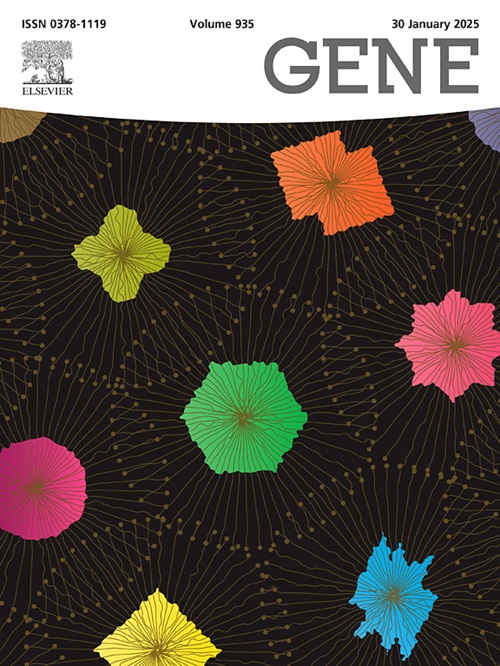叉头盒M1亚型3过表达与成人型弥漫性胶质瘤的恶性程度相关
IF 2.6
3区 生物学
Q2 GENETICS & HEREDITY
引用次数: 0
摘要
forkhead Box M1是一种转录因子,其mRNA和蛋白在各种类型的癌症中都过表达。此外,活性叉头盒M1亚型3 (FOXM1*3)与癌症进展有关。然而,人们对该亚型在脑胶质瘤恶性程度中的作用知之甚少。本研究评估了FOXM1*3过表达与成人型弥漫性胶质瘤(atdg)恶性程度之间的关系。方法对81例atdg患者和10例健康对照皮质进行前瞻性研究。采用Taqman探针对FOXM1*3转录本和内务基因IPO8进行定量分析。肿瘤样本根据其恶性程度和细胞谱系进行分类。通过长期随访观察无进展生存期(PFS)。然后使用Kruskal-Wallis、Mann-Whitney U和log-rank (Mantel-Cox)检验对数据进行分析。结果以星形细胞分化为主,星形细胞瘤和胶质母细胞瘤占80.2%。原发性组织病理分子诊断组为胶质母细胞瘤,占35.8%。对照组与胶质瘤组FOXM1*3表达差异有统计学意义(p <;0.001)。转录本表达在2级、- 3级和- 4级胶质瘤中有显著差异(p <;0.005 - -0.0001)。2级和- 3级星形细胞瘤之间也存在显著差异(p <;0.005)和胶质母细胞瘤(p <;0.0001),但相同级别的星形细胞瘤和少突胶质细胞瘤之间没有差异。结论FOXM1*3的过表达可以纠正判断胶质瘤恶性程度的观察者之间的不一致,特别是在3级胶质瘤中。它可以被看作是一种辅助工具。本文章由计算机程序翻译,如有差异,请以英文原文为准。
Forkhead Box M1 isoform 3 overexpression is associated with malignancy grade in adult-type diffuse gliomas
Background
Forkhead Box M1 is a transcription factor that is overexpressed in both its mRNA and its protein in various types of cancer. The active Forkhead Box M1 isoform 3 (FOXM1*3) is, moreover, associated with cancer progression. However, little is known about the role of this isoform concerning the degree of malignancy in brain gliomas. This study evaluated the association between overexpression of the FOXM1*3 and the degree of malignancy in adult-type diffuse gliomas (ATDGs).
Methods
We conducted a prospective study involving 81 samples from patients with ATDGs and ten samples from healthy control cortices. Quantification of the FOXM1*3 transcript and the housekeeping gene, importin 8 (IPO8), was performed using qPCR with Taqman probes. Tumor samples were classified based on their degree of malignancy and cell lineage. Progression-free survival (PFS) was observed through long-term follow-up. The data were then analyzed using the Kruskal-Wallis, Mann-Whitney U and log-rank (Mantel-Cox) tests.
Results
The most frequent type of cell differentiation was astrocytic, with astrocytomas and glioblastomas accounting for 80.2 % of cases. The primary histopathological-molecular diagnosis group was glioblastoma, at 35.8 %. There was a significant difference in FOXM1*3 expression between the control and glioma groups (p < 0.001). Transcript expression showed significant differences among grade-2, −3, and −4 gliomas (p < 0.005–0.0001). Significant differences were also detected between grade-2 and −3 astrocytomas (p < 0.005) and glioblastomas (p < 0.0001), but not between astrocytomas and oligodendrogliomas of the same grade.
Conclusion
We observed that overexpression of FOXM1*3 can rectify intra-observer discordance in determining the malignancy grade of gliomas, particularly in grade 3. It can be considered a supplementary tool.
求助全文
通过发布文献求助,成功后即可免费获取论文全文。
去求助
来源期刊

Gene
生物-遗传学
CiteScore
6.10
自引率
2.90%
发文量
718
审稿时长
42 days
期刊介绍:
Gene publishes papers that focus on the regulation, expression, function and evolution of genes in all biological contexts, including all prokaryotic and eukaryotic organisms, as well as viruses.
 求助内容:
求助内容: 应助结果提醒方式:
应助结果提醒方式:


